This is a guest blog by Benjamin Feldman, a great Green-Wood and New York City enthusiast who is the author of “Butchery on Bond Street: Sexual Politics and the Burdell-Cunningham Murder Case in Ante-Bellum New York” and “Call Me Daddy: Babes and Bathos in Edward West Browning’s Jazz-Age New York.” Ben blogs at The New York Wanderer.
New York’s City Hall, designed by Green-Wood resident John McComb, Jr. and Joseph Mangin, has stood, majestic, since 1811. It is little changed from the day it was built save an Alabama limestone cladding added in the mid-1950s.
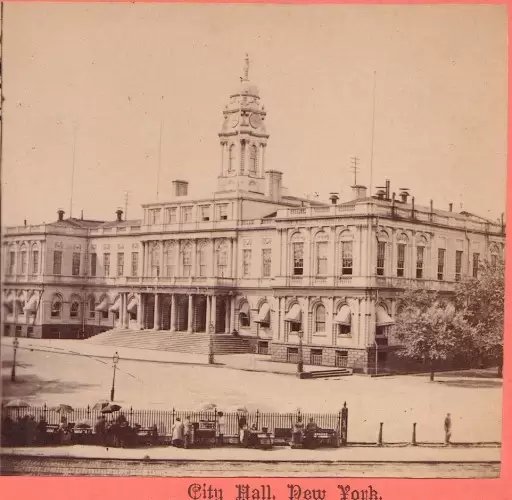
McComb’s name is seldom recognized today, even though several of his buildings survive in Manhattan: Gracie Mansion (1799), now the Mayor of New York City’s official residence in the north end of Carl Schurz Park at 89th Street and East End Avenue, Castle Clinton (1808), the fort at the Battery and Hamilton Grange (1802), Alexander Hamilton’s country estate recently moved to yet another site in St. Nicholas Park in substitution for its original nearby emplacement.
McComb (1763-1853) had a distinguished career in New York and Princeton, New Jersey. Besides residences and churches, he designed lighthouses at Montauk, New York, Eatons Neck, New York, and Cape Henry, Virginia– all three of which survive to this day.
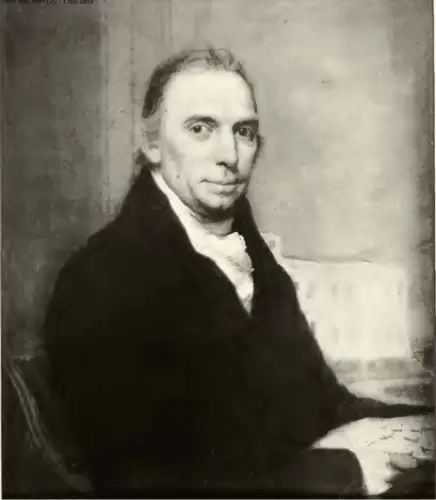
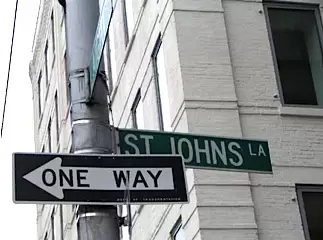
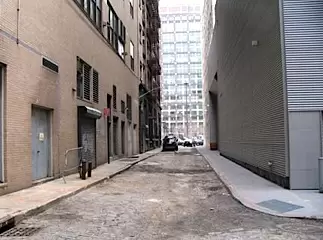
A peculiar palimpsest of one of McComb’s most magnificent designs sits on the corner of Canal and Laight Streets, though, hard bythe southerly side of the Holland Tunnel entrance. The roar of the truck traffic and stench of fumes overwhelm one’s senses as one stands by a simple blue-green street sign. St. John’s Lane survives to this day, paved with Belgian block, a narrow two-block long thoroughfare connecting Canal with tiny Beach Street. Until 1918, the lane ran along the rear of St. John’s Chapel, a Trinity Parish Episcopal Church whose membership in the early 19th century was select and upper crust.
St. John’s Church faced the genteel St. John’s Park, and its communicants counted the likes of George Templeton Strong’s family, and many members of polite downtown New York society in the earliest decades of the 19th century when upper-middle class houses lined Greenwich, Washington and other downtown streets as well as Broadway itself. Here, now, is the St. John’s Chapel in all its glory, inside and out, with views of the park in the days when City Hall Park (then known simply as City Park) was the only significant public (and not so safe!) green space in town.
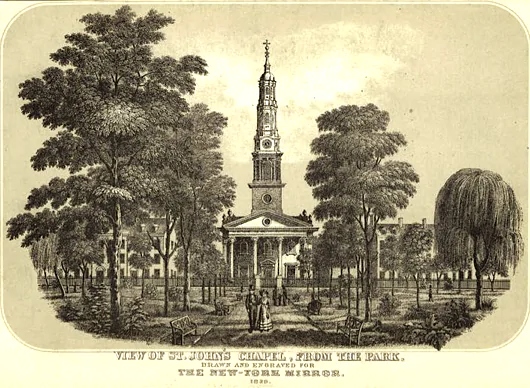
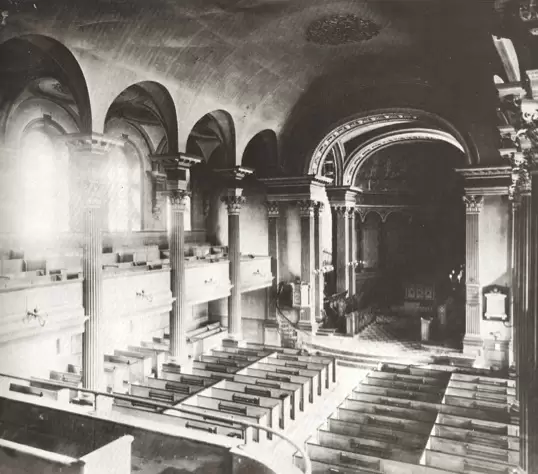
Columbia College frequently held assemblies and commencements in the sanctuary in the decades before and after Strong’s matriculation at what had been known as King’s College in colonial times. The College was located on College Place (now West Broadway), near Barclay Street. John Ericsson, inventor of the Monitor ironclad (several of whose officers are permanent residents of Green-Wood–see that blog post here), lived on adjacent Beach Street at #36, which survived well into the 20th century. The gates to the park were kept locked and access afforded only to local residents. A 1914 article in the New York Times documents the former bygone gentility of the neighborhood.
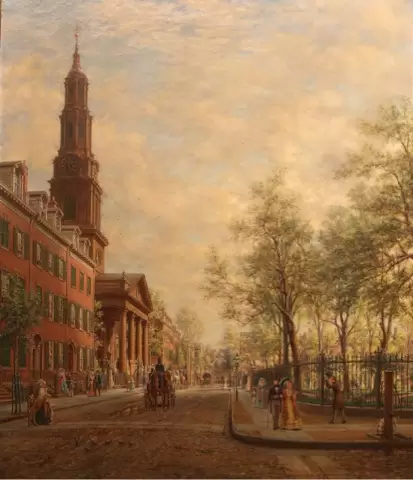
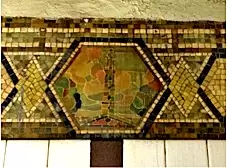
Taken from I.N. Phelps Stokes The Iconography of Manhattan Island (Vol. 3, Addenda Plate 11-c) are the pre-construction sketches McComb did of the Church:
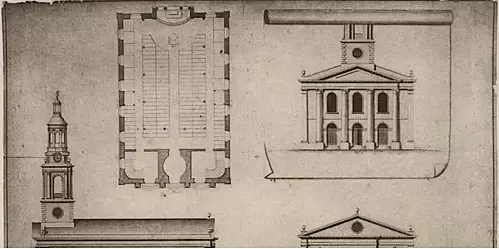
One of McComb’s most magnificent homes still stands at Battery Place. It is the Isaac Watson House, built in 1799 and used for many decades as the Shrine to Saint Elizabeth Seton (who had lived there with her family as a girl).
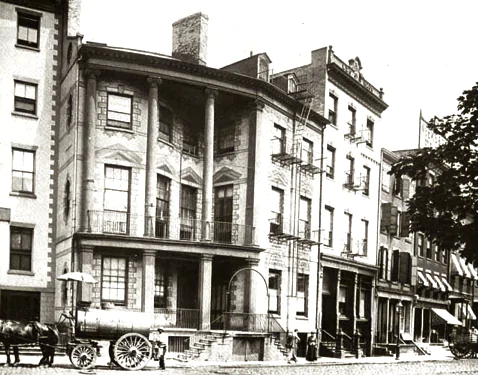
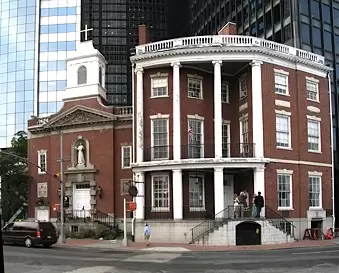
Society moved uptown gradually in the 1820s, 30s and 40s, first to Bond Street, Washington Square and Astor Place, then farther north to Union Square and Gramercy Park, thinning the ranks of St. John’s Church quite dramatically. Gradually, the neighborhood around St. John’s filled with warehouses and factories, and in 1867 Trinity Parish (which owned both the park and the church) sold it to “Commodore” Cornelius Vanderbilt’s Hudson River Railroad for a massive downtown freight terminal.
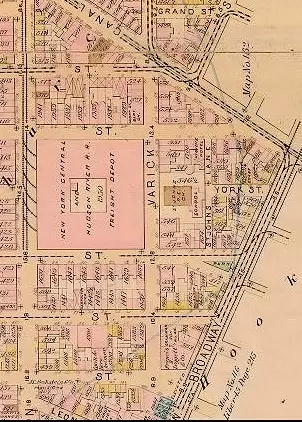
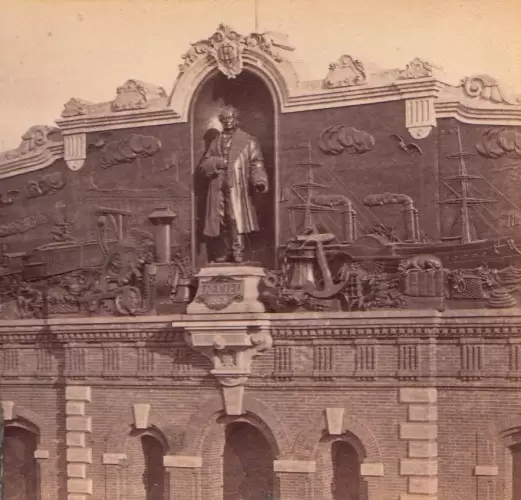
The undesirable influences of grade-level freight operations spread in every direction, and a neighborhood of once patrician dwellings was converted to a crazy quilt of ramshackle buildings and giant lofts. Here is a photo taken as the park was being demolished, leaving the dignified Chapel an orphan in time:
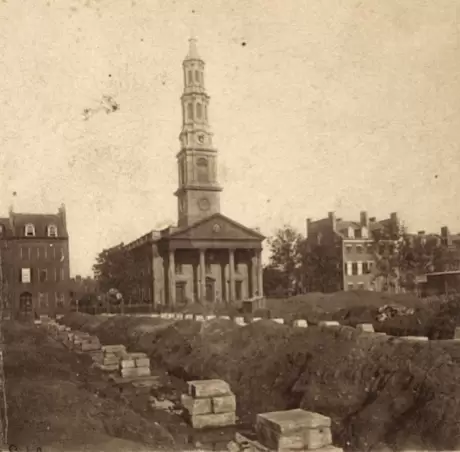
St. John’s congregation left for good in the 1890s and the church was torn down in 1918. It was cleared during a road-widening scheme for New York City’s Varick Street– highly controversial at the time. City officials were cognizant of the landmark importance of the old steeple and wished the portico to remain, projecting into the widened street and vaulting the flanking pedestrian sidewalk. Ever aware of maximizing parish income from its extensive real estate holdings, Trinity Parish instead decided to demolish the building and put the site to other income-producing purposes.
John McComb Jr.’s name may have slipped out of common parlance decades ago, but his memory is preserved at Green-Wood Cemetery where his grave and those of his family lie on a Chapel Avenue hillside, demarcated by a simple obelisk. Canal Street’s roar is far away…
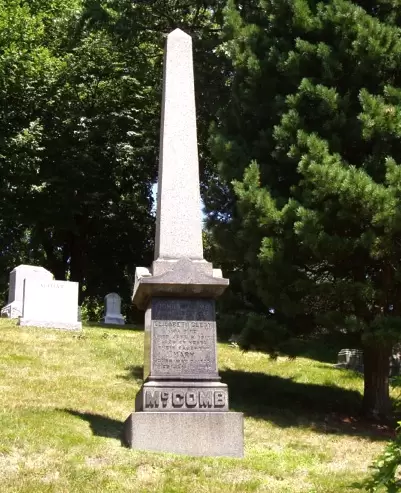
For nearly 20 years I have looked out the back windows of my house at the Eaton’s Neck Lighthouse. It thrills me to know that it was commissioned by John Adams. I did not know the name of its architect until I read this blog! John McComb is a name I will remember now, as it is connected to two place I hold dearly, Green-Wood and the Long Island Sound. The prints of Saint John’s Chapel and Park are lovely! Shame it has been lost for posterity, but it is a comfort that today we are more aware of our architectual heritage. Thanks so much for this story! I am going to share it on Facebook for my friends in Huntington…..
Nice further reading of the Mccomb family.
My husband was a descendent of the family.
I have done a lot of genealogy in the past.
Interesting that some of the traits are still carried on down the lines through someone.
Mine also was a designer and builder of sorts.
Everything he designed was precise. It had to be done correctly.
I would be interested in more history on John. I love reading the history.
Amazing photography! Thanks for sharing these wonderful images with us.. By the way, do you have any photos of the prominent funeral processions held at Green-Wood Cemetery? All i could find was this photo of Joe Gallo’s casket..I could not even find any photography from recent funerals like John Costelloe, Schuyler Garrison Chapin, Leonard Bernstein and Jean-Michel Basquiat, let alone find historic ones..I would be so glad if you post some ”Green-Wood funerals” on your history blog..
Unfortunately, there are very few such images in existence.
I am so very thankful to all in the Society
who have given their time and efforts to bring
the wonderful and sometimes, mysterious facts and
photos to our attention. As a former New York police
officer, assigned not too far from Greenwood, I have
a special interest in all that is unveiled.
Keep up the good work, and bless you all
Maurice (Reno) Bergman
Breitbrunn am Chiemsee
Germany
Thanks! That is very kind of you. Good to know we have a following in Germany!
Thank you so much for this wonderful article about my ancestor, John McComb. My children and I are his only descendants, and I believe I am now the registered “owner” of his plot in Greenwood. I had a chance to visit there a few years ago for the first time. What a wonderful cemetery indeed! You may be amused to know that his father, also named John, was streets commissioner and had the responsibility of horse manure disposal – a huge job in the late 1700s-early 1800s – but fortunately there were farms in northern Manhattan at that time. Peace, and thank you again.
Hi. I’ve become curious about John D. McComb (1830-1896), who arrived in California in 1849 on the steamer Oregon and later, as an editor on the San Francisco “Alta California,” was an important early friend and supporter of Mark Twain. I wonder if he might have been a relative or descendent of your ancestor John McComb, and I’d be grateful for any information you could share. Thanks! — Peter Salwen
I do not know if these two John McCombs were related. However, this seems to have been a pretty common name in 19th-century America. 50 men who served in the Union Army during the Civil War had that name or a variation of it.
I am also a McCombs ancestor and I am researching the family’s emigration across the US to Napa, California by wagon in 1848 with James Clyman. I am trying to put their progression from New York thru to South Bend, Indiana into perspective. I’d appreciate any links you may have thru the 1700’s.
I was told for many years that I was a descendent of John McComb. I grew up on Long Island and we took trips to the Montauk Point Lighthouse every summer. My dad, Grosvenor Adams McCombs, told us every time that we were related to John McComb. He was also a descendant of John Adams brother. The McCombs family that my Grandfather McCombs (who I never met) was from were in upstate New York, near Clinton I was told. This is a wonderful article I can share with my grandchildren. Thank you!